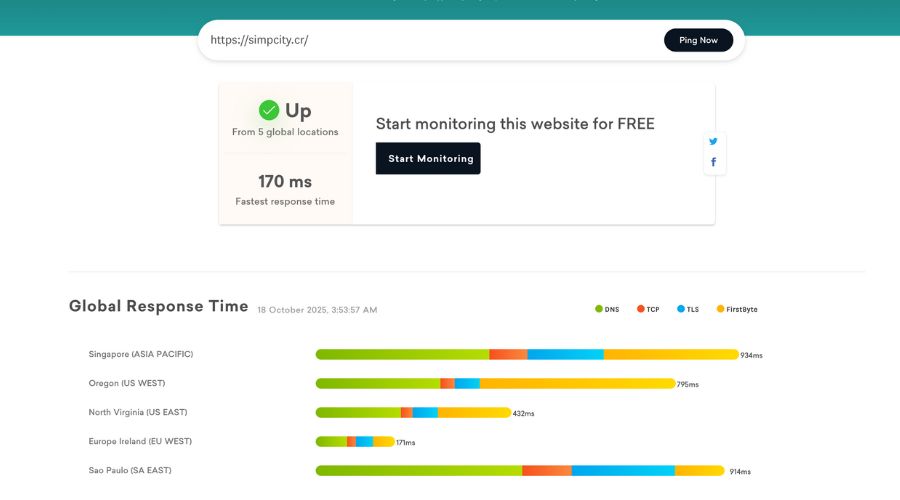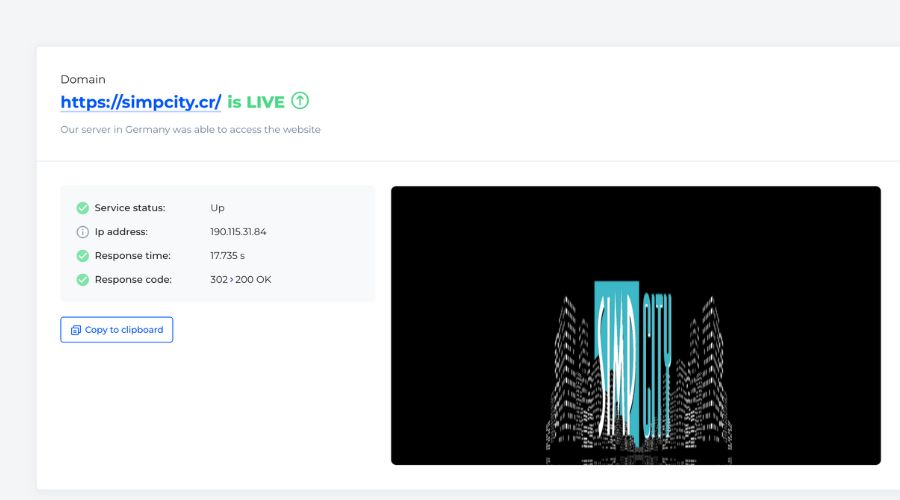✅ Site is up – technically online and working
⚠️ Access is tricky – many users can’t get in
The Issue: SimpCity is running, but there’s a gap between “the site works” and “users can actually use it.” Think of it like a restaurant that’s open but has a bouncer turning people away at the door.
Why This Happens: Sites like this often have access restrictions, invite requirements, account issues, or regional blocks – even when the servers themselves are functioning fine.
Bottom Line: If you’re trying to access it and can’t get in despite the site being “up,” that’s unfortunately the normal experience right now. The technical infrastructure is live, but actual user access is limited.
Current State of Things
Site Accessibility: Multiple monitoring services show SimpCity’s primary domain (simpcity.cr) is responding and online. The platform migrated from simpcity.su to simpcity.cr back in July 2025. But here’s where it gets messy uptime monitoring over a 9-day period shows only 72.8% reliability. Response times average around 1,085ms, though they swing wildly from 0ms all the way up to 30,273ms.
Recent global response testing reveals significant geographical performance disparities that help explain why some users experience faster access than others. Europe Ireland shows the most efficient response at 171ms total, with DNS resolution taking 68ms (39.8% of total time), TCP connection at 18ms (10.5%), TLS handshake at 37ms (21.6%), and first byte delivery at 48ms (28.1%).
In contrast, users accessing from Singapore face considerably slower performance 934ms total response time. DNS resolution alone consumes 385ms (41.2% of the process), followed by TCP at 82ms (8.8%), TLS at 168ms (18.0%), and first byte at 299ms (32.0%). Sao Paulo experiences similarly sluggish performance at 914ms, with DNS taking a particularly heavy toll at 460ms (50.3% of total time).
North American access falls somewhere in the middle. Oregon clocks in at 795ms total, with the first byte delivery accounting for the largest chunk at 437ms (55.0%). North Virginia performs notably better at 432ms, though DNS still represents 188ms (43.5%) of that time. What’s interesting here DNS resolution seems to be a consistent bottleneck across nearly all geographic regions, suggesting potential DNS infrastructure issues or routing inefficiencies.
DDOS Protection: The site runs behind DDOS-Guard protection now, which means users face browser verification checks that can take 5-10 seconds before access is granted. This security layer was added following DDOS attacks, though it’s created an extra hurdle for legitimate users trying to get in. The TLS handshake times ranging from 37ms in Ireland to 227ms in Sao Paulo indicate the DDOS-Guard verification process adds variable latency depending on geographic proximity to their security servers.

The Real Problems Users Are Facing
Login Authentication Breakdown: This seems to be where most of the frustration centers. Users report widespread difficulties logging into accounts, stemming from several authentication failures:
Passkey Issues: Passkeys that worked fine on simpcity.su are now useless on simpcity.cr. Makes sense when you consider passkeys are domain-specific, but users also report that even their backup codes stopped working after the domain change.
Google Login Removed: The third-party Google login integration was disabled entirely. Users who relied solely on this method which apparently was quite a few people are now locked out. Site administrators cited budget constraints and technical expertise limitations as reasons for removing the feature.
Password Reset Nightmares: Attempting password recovery often means waiting hours for reset emails. When they finally arrive, many users find the reset links throw errors saying “your action could not be confirmed, please send another request.” So… back to square one.
Email Confirmation Delays: New registrations experience substantial delays receiving confirmation emails. Some users report waiting 2+ hours, which makes account creation feel like a test of patience.
403 Forbidden Errors
Multiple users hit 403 Forbidden errors when trying to access the site. The pattern here suggests a few potential culprits:
ISP-Level Blocking: Some Internet Service Providers appear to restrict access to SimpCity outright, forcing users to route through VPNs. The site announced plans to implement multiple proxy domains to work around these ISP restrictions though implementation seems inconsistent at best.
IP-Based Access Control: The 403 error often points to IP address blocking, but reports indicate this occurs unpredictably, sometimes even from the same IP address at different times.
DDOS-Guard Conflicts: Occasionally the DDOS-Guard verification process completes but still doesn’t grant access, leaving users staring at 403 errors despite passing the browser check. The extended TLS handshake times observed in regions like Sao Paulo (227ms) and Singapore (168ms) may contribute to verification timeouts that trigger these errors.

Geographic Performance Disparities and Access Issues
The global response time data reveals a clear performance hierarchy that likely influences user experience quality. European users particularly those connecting through Ireland enjoy response times under 200ms, which translates to relatively smooth browsing even with DDOS-Guard verification.
Asia-Pacific users face nearly 5.5x slower response times compared to European access points. This disparity becomes particularly problematic when combined with authentication timeouts or session management issues. If DNS resolution alone takes 385ms in Singapore before even establishing a TCP connection, users in that region attempting rapid page navigation or dealing with session refreshes may encounter frequent timeouts.
South American users from Sao Paulo experience similar challenges, though their bottleneck centers more heavily on DNS (50.3% of total time) compared to Singapore’s more evenly distributed delays. The 460ms DNS resolution time suggests either routing inefficiencies to SimpCity’s nameservers or potential ISP-level DNS filtering that adds lookup overhead.
North American performance splits interestingly between coasts. Oregon’s 795ms response includes a disproportionate 55.0% spent waiting for first byte delivery (437ms), which might indicate server processing delays or congestion during content generation. North Virginia’s 432ms total time, while faster, still shows DNS consuming 43.5% of the process a pattern consistent across all tested regions except Ireland.
September 2025 Data Rollback
In September 2025, SimpCity experienced what can only be described as a significant outage requiring a massive data rollback. Users encountered 503 errors and complete inaccessibility before the forum returned with restored older data. This incident highlights ongoing infrastructure stability concerns that don’t seem fully resolved.
Domain Migration Timeline
The July 2025 transition from simpcity.su to simpcity.cr was reportedly temporary while administrators prepared a multi-domain proxy system. The migration caused:
- A noticeable increase in advertisements and pop-ups on the new domain
- Loss of saved authentication methods tied to the previous domain
- General confusion about which domain to actually use
The domain change likely explains some of the DNS resolution delays observed in global testing. When domains migrate, DNS propagation issues can persist for weeks or even months depending on ISP caching policies and nameserver update frequencies. Users whose ISPs haven’t fully refreshed DNS records may experience longer resolution times or intermittent failures.
SimpTown as an Alternative
During access difficulties, users who maintained logged-in sessions on SimpTown (simptown.su) could still access content threads. SimpTown functions as something of a complementary platform with enhanced viewing features and content browsing. However, it also experiences intermittent downtime though no recent global performance data is available to compare its response characteristics against simpcity.cr.
Geographic and Network Restrictions
The site faces access restrictions from various ISPs globally. SimpCity administrators acknowledged this and announced plans for an official proxy list to help users bypass regional blocks though actual delivery of this solution remains unclear.
Some users encounter “SimpCity is currently in maintenance mode” messages that prevent access even with correct credentials. Whether this reflects actual maintenance or another access control issue is difficult to determine. Given the performance data showing functional connectivity across multiple global test points, these maintenance messages may be location-specific or tied to specific user sessions rather than site-wide outages.
User Community Response
Reddit communities show considerable frustration. Common complaints include:
- Minimal communication from administrators during outages
- No visible updates on the official Telegram channel during critical downtime
- Help resources that require logging in to access (which is… ironic, given the login issues)
- Loss of saved favorites and bookmarks following rollbacks
Users from Asia-Pacific and South American regions appear particularly vocal about performance issues, which aligns with the response time data showing these regions experience 4-5x slower access compared to European connections.
Technical Infrastructure Concerns
Security vs. Accessibility: Following DDOS attacks, SimpCity implemented protective measures that inadvertently created access barriers. Email domain whitelisting restrictions, rate limiting affecting legitimate users, browser verification checks that sometimes fail these security layers may be necessary, but they’re clearly causing collateral damage.
Server Performance: Monitoring data reveals inconsistent server response times and multiple reported outages from various locations globally. The platform seems to struggle handling traffic loads, particularly after content updates. The global response testing indicates the infrastructure may be optimized primarily for European access, with other regions experiencing degraded performance possibly due to:
- Insufficient CDN coverage or edge server distribution
- DNS nameservers concentrated in specific geographic regions
- Backend servers located primarily in Europe, forcing distant users through longer routing paths
- TLS certificate verification processes that add latency for non-European connections
The fact that DNS resolution consistently represents 34-50% of total response time across regions (except Ireland at 39.8%) suggests DNS infrastructure improvements could yield significant performance gains.
Troubleshooting Options
For users experiencing access issues, a few potential solutions some of which may be more effective depending on geographic location:
Authentication:
- Creating a new account with a fresh email if password reset fails
- Avoiding passkeys until administrators resolve domain-specific issues
- Checking for confirmation emails 2+ hours after account creation (patience required)
Connection:
- Using a VPN if hitting 403 errors, since some ISPs block access. European VPN endpoints may provide faster access based on response time data
- Clearing browser cache and cookies before attempting access
- Waiting through the full DDOS-Guard verification (give it the full 5-10 seconds, or longer if connecting from Asia-Pacific or South America)
- Trying alternative domains like simptown.su if simpcity.cr is inaccessible
DNS:
- Switching to alternative DNS servers like Google DNS (8.8.8.8) or Cloudflare (1.1.1.1) this may provide particular benefit given DNS resolution represents such a large percentage of total response time
- Flushing local DNS cache for fresh resolution
- For users in Singapore or Sao Paulo regions, using DNS servers geographically closer to European locations might reduce resolution overhead
Geographic Considerations:
- Users in Asia-Pacific or South America should expect inherently slower performance (800-900ms+) due to infrastructure limitations
- Setting longer browser timeout values may prevent premature connection failures in high-latency regions
- During peak usage times, users in distant geographic regions may experience even worse performance due to server load combined with latency
What to Expect Going Forward
The platform appears to be struggling with balancing security needs against user accessibility. Administrators have committed to implementing multiple proxy domains and improving infrastructure, but execution seems… inconsistent, to put it mildly. The removal of third-party login options and persistent authentication issues suggest resource constraints are affecting platform maintenance more than administrators may want to admit.
The geographic performance data raises questions about infrastructure investment priorities. With European access performing nearly 5x faster than Asian or South American access, there’s either a conscious decision to prioritize European users or a lack of resources to deploy geographically distributed infrastructure. For a platform with global user reach, this performance disparity will likely continue driving user frustration unless addressed through CDN implementation or regional server deployment.
As of today, SimpCity is technically operational but plagued by significant usability issues. Users should expect intermittent access difficulties, particularly around account authentication. Geographic location plays a substantial role in access quality European users may experience relatively smooth access (sub-200ms), while Asian and South American users face response times approaching 1 second before content even begins loading. The site remains functional for those able to maintain persistent login sessions or access through alternative domains like SimpTown but for everyone else, it’s a gamble whether access will work on any given attempt, with odds varying significantly based on where in the world they’re connecting from.

